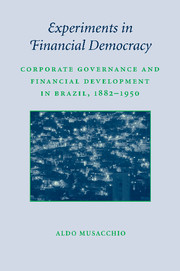 Experiments in Financial Democracy
Experiments in Financial Democracy Book contents
- Frontmatter
- Contents
- List of Figures and Tables
- Preface
- Acknowledgments
- 1 Introduction
- 2 Financial Development in Brazil in the Nineteenth Century
- 3 The Stock Exchange and the Early Industrialization of Brazil, 1882–1930
- 4 The Foundations of Financial Democracy: Disclosure Laws and Shareholder Protections in Corporate Bylaws
- 5 Voting Rights, Government Guarantees, and Ownership Concentration, 1890–1950
- 6 Directors, Corporate Governance, and Executive Compensation in Brazil, c. 1909
- 7 Bond Markets and Creditor Rights in Brazil, 1850–1945
- 8 Were Bankers Acting as Market Makers?
- 9 What Went Wrong after World War I?
- 10 The Rise of Concentrated Ownership in the Twentieth Century
- 11 Conclusion
- Bibliography
- Index
- STUDIES IN MACROECONOMIC HISTORY
4 - The Foundations of Financial Democracy: Disclosure Laws and Shareholder Protections in Corporate Bylaws
Published online by Cambridge University Press: 30 January 2010
- Frontmatter
- Contents
- List of Figures and Tables
- Preface
- Acknowledgments
- 1 Introduction
- 2 Financial Development in Brazil in the Nineteenth Century
- 3 The Stock Exchange and the Early Industrialization of Brazil, 1882–1930
- 4 The Foundations of Financial Democracy: Disclosure Laws and Shareholder Protections in Corporate Bylaws
- 5 Voting Rights, Government Guarantees, and Ownership Concentration, 1890–1950
- 6 Directors, Corporate Governance, and Executive Compensation in Brazil, c. 1909
- 7 Bond Markets and Creditor Rights in Brazil, 1850–1945
- 8 Were Bankers Acting as Market Makers?
- 9 What Went Wrong after World War I?
- 10 The Rise of Concentrated Ownership in the Twentieth Century
- 11 Conclusion
- Bibliography
- Index
- STUDIES IN MACROECONOMIC HISTORY
Summary
Corporations are republics. The ultimate authority rests with voters (shareholders).
Paul Gompers et al., “Corporate Governance and Equity Prices,” 2003.That Brazil had relatively large equity markets before 1915 should make us wonder what institutional system was in place in this country that provided national and foreign investors enough securities to buy equity issued by local companies. One possibility is that Company Laws passed in 1882, 1890, and 1891 provided strong protections for investors. In particular we would want to know if small investors were protected against the power or abuses of managers or insiders (e.g., large shareholders).
Some works in the law and finance literature argues that protection for minority shareholders is aff orded by a basic set of principles, or rights, embodied in corporate laws with which companies are obliged to comply. Smaller investors are presumed to be encouraged by these protections to participate in the ownership of corporations, thereby deepening equity markets. Evidence for the 1990s reveals that equity markets tended to be larger and more corporations tended to be traded on the stock exchanges of countries in which small shareholders were accorded greater protection in national company laws. Th us, this chapter first explores whether the set of investor protections La Porta et al. consider relevant for the protection of small shareholders was present during the first boom in stock market development in Brazil.
In other countries there is evidence that these protections were not necessary for the development of equity markets.
- Type
- Chapter
- Information
- Experiments in Financial DemocracyCorporate Governance and Financial Development in Brazil, 1882–1950, pp. 84 - 104Publisher: Cambridge University PressPrint publication year: 2009
